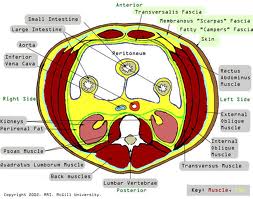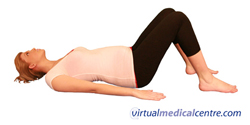What is Diastasis Rectus ?
Diastasis Rectus refers to the separation of the rectus abdominis muscle into two halves. Normally it is attached together by a fibrous tissue called the linea alba.
It is common in late pregnancy or post-natally as the rectus abdominis is stretched by the growing uterus. Presence of diastasis rectus is palpated as a hollow or trough between superficial rectus abdominus muscle. The condition can be diagnosed by physical examination by your physiotherapist.
How does it happen?
During pregnancy, hormones soften the connective tissue, causes loosening of abdominal fascia. Mechanical stress on the abdominals can also cause diastasis rectus or recti. A diastasis recti may appear as a ridge running down the midline of the abdomen, anywhere from the breast bone to the pubic bone. It becomes more prominent with straining and may disappear when the abdominal muscles are relaxed. Diastasis recti effects how the abdominal muscles function and have implications for the stability of the pelvis and lumbar spine. Pre-disposing factors for diastasis rectus include weight gain during pregnancy, the mothers age and exercise level and the baby’s birth weight.
What should you do?
If you have or suspect you have diastasis rectus, you should consult your physiotherapist. It can be corrected with physiotherapy treatment or, in extreme cases, it can be corrected with surgery.
What shouldn’t you do?
If you have or suspect you have diastasis rectus, you shouldn’t ignore the problem. This can lead to your problem getting worse or prolonging your recovery.
Could there be any long-term effects?
In many cases there are no long-term effects, as long as the problem is properly diagnosed and appropriately treated. If left untreated the diastasis rectus can affect the strength of the thoracolumbar fascia and deep abdominal muscles which supports the low back and pelvis. The deep abdominal muscles become less functional and this can lead to muscle imbalances, changes in posture and low back pain.
Management
The assistance of a physiotherapist is important in the treatment of diastasis rectus. Initially they can assist in confirming your diagnosis and establishing its severity. From this assessment the physiotherapist will be able to determine an appropriate treatment plan. This may involve activity modification, exercise and using a brace for support. Deep abdominal and pelvic floor strengthening is used to manage diastasis rectus. A brace can be used to provide support and act as a reminder to activate deep abdominal muscles.
How to activate your pelvic floor or deep abdominal muscles:
Activating your deep abdominal muscles (transversus abdominus) helps to hold the separated muscles together. The transversus abdominus muscles work together with the pelvic floor muscles to stabilise the abdominal wall and the lower back.
It is always best to have a physiotherapist assess your transversus abdominus / pelvic floor activation to ensure you are doing the contraction correctly, however the basic contraction is as follows:
- Start by lying on your back with both knees bent up, or on your side with a pillow between your knees.
- Try to do some relaxed breaths, don’t tense your abdomen.
- Now on a breath out, try to slowly and gently draw your lower abdomen (just above your pubic bone) in towards your spine. You should feel a very mild tension or tightening in the lower abdomen – it is NOT a strong or fast contraction. Hold this contraction and keep breathing for 4-5 breaths. Then relax.
- If the abdominal contraction is too difficult, try thinking about your pelvic floor. On a breath out, slowly and gently draw up your pelvic floor, as though you were trying to stop the flow of urine while going to the toilet (for men, think of trying to lift the testicles up). Hold this contraction while you keep breathing for 4-5 breaths.
- You should not get any movement in your lower back or pelvis, nor should you get any pain with this exercise.
- You can palpate (or feel) the contraction with your fingertips placed gently inside the bony prominences of your hips. As you contract you should feel a slight drawing in (no bulging), as you relax you should feel the contraction melting away.
Gold Coast Physiotherapy and Allied Health at Burleigh Heads and Broadbeach










